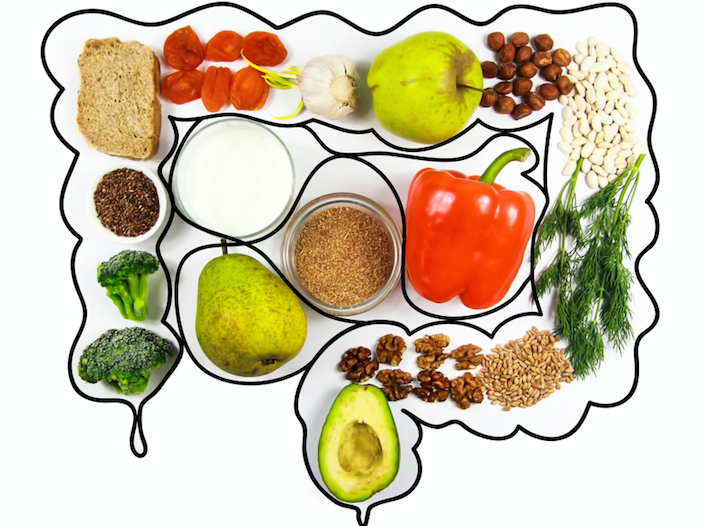
The fibers of life
Written by Heather Ervin
(Credit: Shutterstock/Poligoone)
Protein intake is commonly seen as one of the most important aspects of nutrition because it builds and operates human cells. An often-overlooked fact is that there are other important cells in the human body that need energy and care as well: bacterial cells.
These cells outnumber human cells and operate everything from your immune system to how genes express themselves. There are over 1,000 known species in the body and over 40 trillion of them inside you right now are switching on and off physical and mental operations. What keeps them healthy and powered is not protein but fermentable fibers.
Fiber from food falls into two categories: soluble and insoluble. Insoluble fiber expands when liquid is added to it. This fiber races through the intestinal track without absorbing, giving it the “insoluble” title. Supermarket shelves are filled with high insoluble fiber foods, including nuts, seeds and green vegetables.
Most foods that contain insoluble fiber also contain some soluble fiber. This second type of fiber creates a gel by binding with fatty acids and it starts fermenting in the stomach. Fibers that ferment are important to the overall health of the human system for one main reason; they feed the 40 trillion bacteria controlling your responses to the environment around you. Activation of your DNA, emotions, behavior, the central nervous system, disease manifestation, and much more are all controlled by these little living organisms.
2019 WHO STUDY
Fiber’s overall impact on long-term disease prevention was well gauged in a 2019 study sponsored by the World Health Organization. The purpose was to assess the impact of all fiber on non-communicable diseases. The study also looked at the amount of fiber consumed in relationship to weight reduction. The results reported to the world in The Lancet (Jan 2019) included 185 observational studies—amounting to 135 million person-years—and 58 clinical trials over almost 40 years. This research found that people who consume the most fiber in their diet are 15–30% less likely to die prematurely from any cause or a cardiovascular condition, compared with those who eat the least fiber. Consuming foods rich in fiber correlated with a 16–24% lower incidence of coronary heart disease, stroke, Type 2 diabetes, and colon cancer. The Study further showed that the break point for this fibrous reduction in disease was 29 grams of fiber a day. By comparison, the average American consumes 15 grams or less daily.
With every “magical” food there comes a debate, opinion and more research. Nuances exist in fiber consumption starting with which fibers may be “better” for the human system. Back in 2012, A. J. Wanders and colleagues published a paper (Obes Rev; 2011 Sep; 12(9):724-39) showing that weight reduction based on fiber consumption occurred more prevalently with “fibers characterized as being more viscous (soluble) reduced appetite more often than those less viscous fibers (insoluble) (59% vs. 14%)”. Eating higher amounts of soluble fiber may be more advantageous to those looking for weight reduction. Research has also shown that soluble fiber supports stronger gut health overall.
GUT ISSUES
On the flipside, fiber can sometimes feel like an irritant to those with irritable bowels and other gut issues. Discomfort can occur as dosage goes up from insoluble fibers that increase “intestinal bulk.” Insoluble fiber expands while passing through the intestines as moisture accumulates in it. Adding to that discomfort may be the soluble fiber that starts fermenting in the stomach.
Together, they can yield bloating, gas and pressure on gut mechanoreceptors that can quickly spark the consumer to back off their consumption. When increasing your fiber intake, always start off slow and work up to a higher amount. While studies do not support the replacement of fiber with resistant starches, research shows certain types of resistant starch are a powerhouse for gut health. They fly through the intestine like insoluble fibers without absorbing and with a bit less expansion and irritation.
Eventually, resistant starches arrive at the colon where they ferment and keep our little friends strong and healthy. Like fiber, resistant starch’s lack of absorption in the intestines helps prevent these carbohydrates from becoming a fast sugar spike and entering the blood stream at a high rate.
These starches can be found in foods, such as green bananas, plantains, cooked and then cooled potatoes, cooked and then cooled rice and beans, dandelion greens, and tapioca or cassava starch.
Fiber is indeed necessary. Its support of human health through decreasing our risk of non-communicable diseases and fortification of mental health functions will allow us to maintain a quality of life and ability to live well.
Nothing in this article constitutes medical advice. All medical advice should be sought from a medical professional.




